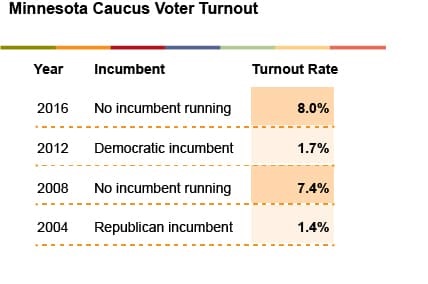Seven things to know about 2018 voter turnout in Minnesota
As Minnesota’s 2020 presidential primary on March 3 gets closer, we at Minnesota Compass pulled together some of the most interesting facts about voters in Minnesota in the most recent statewide elections, the 2018 midterms.
1. Minnesota led the nation in eligible voter turnout. Iowans may vote first, but Minnesotans are first in voting! At 64% turnout, Minnesota had the highest voting rate in the country. 2018 also saw a huge 13.5 percentage point increase in turnout compared to the 2014 midterms, which was the only election in the past 15 years that Minnesota did not top the list on this measure. It is great to see Minnesota leading the nation again.
2. Young adult turnout surged. Voter turnout among Minnesotans ages 18-24 nearly doubled compared to the 2014 midterms, from about 2 in 10 (21.6%) to about 4 in 10 (42.7%). However, the youngest voters still have the lowest turnout rate of all age groups.
3. Older adult turnout also hit a milestone. Older voters generally vote at a high rate in midterm elections, but Minnesota’s 2018 turnout among voters 65+ was notable in that it actually surpassed turnout in the 2016 presidential election.
4. Voters of Color narrowed the gap with non-Hispanic White voters. More than half of Minnesotans of Color voted in the 2018 midterms, a 22-point surge compared to 2014. Non-Hispanic White Minnesotans still vote at a higher rate, but the gap was cut in half compared to four years ago.
5. Increased voter turnout was concentrated among wealthier and better educated voters. The increase in 2018 turnout was almost exclusively among voters with at least some college courses, and with household incomes above $50,000. Minnesotans with a high school degree or less, and with lower household incomes, turned out at roughly the same rates as in 2014.
6. Women vote at a higher rate than men in most Minnesota elections, and Minnesotan women had about a point higher increase in 2018 turnout compared to the 2014 midterms.
7. Caucus turnout has been low historically, particularly in years where an incumbent president is running for re-election. However, 2020 marks the first year that Minnesotans will choose their party’s candidate in a primary, rather than a caucus. Primaries generally have much higher turnout than caucuses, since they offer more flexibility and a lower time commitment.

